Snapshots of archaeal DNA replication and repair in living cells using super-resolution imaging
- PMID: 30212908
- PMCID: PMC6237752
- DOI: 10.1093/nar/gky829
Snapshots of archaeal DNA replication and repair in living cells using super-resolution imaging
Abstract
Using the haloarchaeon Haloferax volcanii as a model, we developed nascent DNA labeling and the functional GFP-labeled single-stranded binding protein RPA2 as novel tools to gain new insight into DNA replication and repair in live haloarchaeal cells. Our quantitative fluorescence microscopy data revealed that RPA2 forms distinct replication structures that dynamically responded to replication stress and DNA damaging agents. The number of the RPA2 foci per cell followed a probabilistic Poisson distribution, implying hitherto unnoticed stochastic cell-to-cell variation in haloarchaeal DNA replication and repair processes. The size range of haloarchaeal replication structures is very similar to those observed earlier in eukaryotic cells. The improved lateral resolution of 3D-SIM fluorescence microscopy allowed proposing that inhibition of DNA synthesis results in localized replication foci clustering and facilitated observation of RPA2 complexes brought about by chemical agents creating DNA double-strand breaks. Altogether our in vivo observations are compatible with earlier in vitro studies on archaeal single-stranded DNA binding proteins. Our work thus underlines the great potential of live cell imaging for unraveling the dynamic nature of transient molecular interactions that underpin fundamental molecular processes in the Third domain of life.
Figures

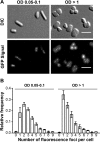
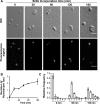
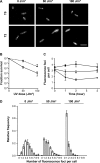
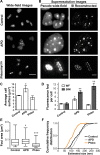
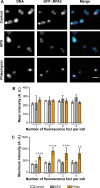

Similar articles
-
Intracellular dynamics of archaeal FANCM homologue Hef in response to halted DNA replication.Nucleic Acids Res. 2013 Dec;41(22):10358-70. doi: 10.1093/nar/gkt816. Epub 2013 Sep 17. Nucleic Acids Res. 2013. PMID: 24049073 Free PMC article.
-
DNA damage induces nucleoid compaction via the Mre11-Rad50 complex in the archaeon Haloferax volcanii.Mol Microbiol. 2013 Jan;87(1):168-79. doi: 10.1111/mmi.12091. Epub 2012 Nov 30. Mol Microbiol. 2013. PMID: 23145964 Free PMC article.
-
Identification of essential and non-essential single-stranded DNA-binding proteins in a model archaeal organism.Nucleic Acids Res. 2012 Feb;40(3):1077-90. doi: 10.1093/nar/gkr838. Epub 2011 Oct 5. Nucleic Acids Res. 2012. PMID: 21976728 Free PMC article.
-
Haloferax volcanii-a model archaeon for studying DNA replication and repair.Open Biol. 2020 Dec;10(12):200293. doi: 10.1098/rsob.200293. Epub 2020 Dec 2. Open Biol. 2020. PMID: 33259746 Free PMC article. Review.
-
Archaeal DNA replication and repair: new genetic, biophysical and molecular tools for discovering and characterizing enzymes, pathways and mechanisms.FEMS Microbiol Rev. 2018 Jul 1;42(4):477-488. doi: 10.1093/femsre/fuy017. FEMS Microbiol Rev. 2018. PMID: 29912309 Review.
Cited by
-
Non-equivalent genomes in polyploid prokaryotes.Nat Microbiol. 2022 Feb;7(2):186-188. doi: 10.1038/s41564-021-01034-3. Nat Microbiol. 2022. PMID: 34949829 No abstract available.
-
BrdU Incorporation and Labeling of Nascent DNA to Investigate Archaeal Replication Using Super-Resolution Imaging.Methods Mol Biol. 2022;2522:419-434. doi: 10.1007/978-1-0716-2445-6_29. Methods Mol Biol. 2022. PMID: 36125768
-
Community Structure and Predicted Functions of Actively Growing Bacteria Responsive to Released Coral Mucus in Surrounding Seawater.Microbes Environ. 2023;38(3):ME23024. doi: 10.1264/jsme2.ME23024. Microbes Environ. 2023. PMID: 37704450 Free PMC article.
-
Haloferax volcanii: a versatile model for studying archaeal biology.J Bacteriol. 2025 Jun 24;207(6):e0006225. doi: 10.1128/jb.00062-25. Epub 2025 May 14. J Bacteriol. 2025. PMID: 40366157 Free PMC article. Review.
-
Live Imaging of a Hyperthermophilic Archaeon Reveals Distinct Roles for Two ESCRT-III Homologs in Ensuring a Robust and Symmetric Division.Curr Biol. 2020 Jul 20;30(14):2852-2859.e4. doi: 10.1016/j.cub.2020.05.021. Epub 2020 Jun 4. Curr Biol. 2020. PMID: 32502411 Free PMC article.
References
-
- Myllykallio H., Lopez P., Lopez-Garcia P., Heilig R., Saurin W., Zivanovic Y., Philippe H., Forterre P.. Bacterial mode of replication with eukaryotic-like machinery in a hyperthermophilic archaeon. Science. 2000; 288:2212–2215. - PubMed
-
- Robinson N.P., Dionne I., Lundgren M., Marsh V.L., Bernander R., Bell S.D.. Identification of two origins of replication in the single chromosome of the archaeon Sulfolobus solfataricus. Cell. 2004; 116:25–38. - PubMed
-
- Edgell D.R., Doolittle W.F.. Archaea and the origin(s) of DNA replication proteins. Cell. 1997; 89:995–998. - PubMed
Publication types
MeSH terms
Substances
LinkOut - more resources
Full Text Sources
Other Literature Sources

